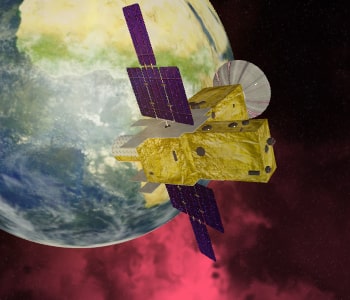
Dr. Abolfazl Shirazi is a senior data scientist, AI engineer, and the CEO and founder of Zerua Tech. His expertise spans machine learning, optimization, and
evolutionary computations in variety of engineering disciplines. In 2016, he was awarded the La Caixa Fellowship Grant for his doctoral studies, and in 2021, he earned his Ph.D. degree with a
“Sobresaliente Cum Laude” distinction from the University of the Basque Country UPV/EHU in computer science. He also served as a postdoctoral researcher at Basque Center for Applied
Mathematics (BCAM) for over two years in the machine learning group. His research interests include astrodynamics and machine learning, focusing on spacecraft trajectory optimization,
evolutionary computations, space dynamics and control, numerical simulation, orbital mechanics, meta-heuristics, and software development for space and maritime applications. In 2023, he
founded Zerua Tech, a startup focused on the development of advanced algorithms, software, and applications. The company leverages artificial intelligence techniques, including machine
learning and optimization, to address engineering challenges across various scientific and engineering domains, notably in space engineering and the maritime industry.
Skills
DATA SCIENCE TENSORFLOW
KERAS | PYTORCH
SCIKIT-LEARN
PANDAS | SCIPY
NUMPY
MATPLOTLIB
OPENCV
KERAS | PYTORCH
SCIKIT-LEARN
PANDAS | SCIPY
NUMPY
MATPLOTLIB
OPENCV
PROGRAMMING PYTHON
C++ | C#
MATLAB | OCTAVE
SQL | BASH
GIT
C++ | C#
MATLAB | OCTAVE
SQL | BASH
GIT
SIMULATION SIMULINK
GMAT | STK
GMAT | STK
MODELING BLENDER
AUTOCAD
AUTOCAD
WEB DJANGO | PHP
JAVASCRIPT
NODE.JS
THREE.JS
CSS | HTML
JAVASCRIPT
NODE.JS
THREE.JS
CSS | HTML
Research Areas
MACHINE LEARNING:
- Artificial Neural Network
- Classification
- Regression Predictions
- Feature Engineering
- Clustering
- Anomaly Detection
OPTIMIZATION:
- Metaheuristics
- Evolutionary Algorithms
- Multi-objective Optimization
- Estimation of Distribution Algorithms
- Constrained Optimization
- Nonlinear programming
Applications

Astrodynamics
Orbit Propagation
Orbital Maneuvers
Trajectory Optimization
Interplanetary Transfers

Spacecraft Dynamics
Spacecraft Guidance
Satellite Attitude Control
Space Mission Analysis
G.N.C Systems

Maritime Engineering
AIS Data Analysis
Route Prediction
Estimation of Arrival Time
Port Congestion
Book Chapter
|
|
Time-Varying Lyapunov Control Laws with Enhanced Estimation of Distribution Algorithm for
Low-Thrust Trajectory Design Shirazi, A., Holt, H., Armellin, R. and Baresi, N. Modeling and Optimization in Space Engineering (2023) DOI: 10.1007/978-3-031-24812-2_14 Abstract:
Enhancements in evolutionary optimization techniques are rapidly growing in many aspects of engineering, specifically in astrodynamics and space trajectory
optimization and design. In this chapter, the problem of optimal design of space trajectories is tackled via an enhanced optimization algorithm within the framework of Estimation of
Distribution Algorithms (EDAs), incorporated with Lyapunov and Q-law feedback control methods. First, both a simple Lyapunov function and a Q-law are formulated in Classical Orbital
Elements (COEs) to provide a closed-loop low-thrust trajectory profile. The weighting coefficients of these controllers are approximated with various degrees of Hermite interpolation
splines. Following this model, the unknown time series of weighting coefficients are converted to unknown interpolation points. Considering the interpolation points as the decision
variables, a black-box optimization problem is formed with transfer time and fuel mass as the objective functions. An enhanced EDA is proposed and utilized to find the optimal variation
of weighting coefficients for minimum-time and minimum-fuel transfer trajectories. The proposed approach is applied in some trajectory optimization problems of Earth-orbiting
satellites. Results show the efficiency and the effectiveness of the proposed approach in finding optimal transfer trajectories. A comparison between the Q-law and simple Lyapunov
controller is done to show the potential of the potential of the EEDA in enabling the simple Lyapunov controller to recover the finer nuances explicitly given within the analytical
expressions in the Q-law.
|
Featured Articles
|
|
Minimum-Fuel Low-Thrust Trajectory Optimization Via a Direct Adaptive Evolutionary
Approach Shirazi, A. IEEE Transactions on Aerospace and Electronic Systems (2023) DOI: 10.1109/TAES.2023.3335906 Abstract:
Space missions with low-thrust propulsion systems are of appreciable interest to space agencies because of their practicality due to higher specific impulses. This
research proposes a technique to the solution of minimum-fuel non-coplanar orbit transfer problem. A direct adaptive method via Fitness Landscape Analysis (FLA) is coupled with a
constrained evolutionary technique to explore the solution space for designing low-thrust orbit transfer trajectories. Taking advantage of the solution for multi-impulse orbit transfer
problem, and parameterization of thrust vector, the orbital maneuver is transformed into a constrained continuous optimization problem. A constrained Estimation of Distribution
Algorithms (EDA) is utilized to discover optimal transfer trajectories, while maintaining feasibility of the solutions. The low-thrust trajectory optimization problem is characterized
via three parameters, referred to as problem identifiers, and the dispersion metric is utilized for analyzing the complexity of the solution domain. Two adaptive operators including the
kernel density and outlier detection distance threshold within the framework of the employed EDA are developed, which work based on the landscape feature of the orbit transfer problem.
Simulations are proposed to validate the efficacy of the proposed methodology in comparison to the non-adaptive approach. Results indicate that the adaptive approach possesses more
feasibility ratio and higher optimality of the obtained solutions.
|
|
|
Adaptive Estimation of Distribution Algorithms for Low-Thrust Trajectory Optimization Shirazi, A. Journal of Spacecraft and Rockets (2023) DOI: 10.2514/1.A35570 Abstract:
A direct adaptive scheme is presented as an alternative approach for minimum-fuel low-thrust trajectory design in non-coplanar orbit transfers using fitness
landscape analysis (FLA). The spacecraft dynamics is modeled with respect to modified equinoctial elements by considering J2 orbital perturbations. Taking into account the timings of
thrust arcs, the discretization nodes for thrust profile, and the solution of multi-impulse orbit transfer, a constrained continuous optimization problem is formed for low-thrust
orbital maneuvers. An adaptive method within the framework of the estimation of distribution algorithms (EDA) is proposed, which aims at conserving the feasibility of the solutions
within the search process. Several problem identifiers for low-thrust trajectory optimization are introduced, and the complexity of the solution domain is analyzed by evaluating the
landscape feature of the search space via FLA. Two adaptive operators are proposed, which control the search process based on the need for exploration and exploitation of the search
domain to achieve optimal transfers. The adaptive operators are implemented in the presented EDA and several perturbed and nonperturbed orbit transfer problems are solved. The results
confirm the effectiveness and reliability of the proposed approach in finding optimal low-thrust transfer trajectories.
|
|
|
Robust estimation of distribution algorithms via fitness landscape analysis for
optimal low-thrust orbital maneuvers Shirazi, A. Applied Soft Computing (2023) DOI: 10.1016/j.asoc.2023.110473 Abstract:
One particular kind of evolutionary algorithms known as Estimation of Distribution Algorithms (EDAs) has gained the attention of the aerospace industry for its
ability to solve nonlinear and complicated problems, particularly in the optimization of space trajectories during on-orbit operations of satellites. This article describes an effective
method for optimizing the trajectory of a spacecraft using an evolutionary approach based on EDAs, incorporated with fitness landscape analysis (FLA). The approach utilizes flexible
operators that are paired with seeding and selection mechanisms of EDAs. Initially, the orbit transfer problem is mathematically modeled and the objectives and constraints are
identified. The landscape feature of the search space is analyzed via the dispersion metric to measure the modality and ruggedness of the search domain. The obtained information are
used as feedback in developing adaptive operators for truncation factor and constraints separation threshold of the employed EDA. A framework for spacecraft trajectory optimization has
been presented where the dispersion value for a space mission is estimated using a k-nearest neighbors (k-NN) algorithm. The suggested method is used to solve several problems related
to low-thrust orbit transfer of satellites in Earth’s orbit. Results demonstrate that the suggested framework for trajectory design and optimization of space transfers is effective
enough to offer fuel-efficient and energy-efficient maneuvers for different thrust levels of the propulsion system. Moreover, the performance of the proposed approach is evaluated
against non-adaptive EDA and other advanced evolutionary algorithms. The obtained results certify that the proposed adaptive evolutionary approach is superior in identifying feasible
minimum-fuel and minimum-energy transfer trajectories.
|
|
|
EDA++: Estimation of Distribution Algorithms with Feasibility Conserving Mechanisms for Constrained
Continuous Optimization Shirazi, A., Ceberio, J. and Lozano, J.A. IEEE Transactions on Evolutionary Computation (2022) DOI: 10.1109/TEVC.2022.3153933 Abstract:
Handling non-linear constraints in continuous optimization is challenging, and finding a feasible solution is usually a difficult task. In the past few decades,
various techniques have been developed to deal with linear and non-linear constraints. However, reaching feasible solutions has been a challenging task for most of these methods. In
this paper, we adopt the framework of Estimation of Distribution Algorithms (EDAs) and propose a new algorithm (EDA++) equipped with some mechanisms to deal with non-linear constraints.
These mechanisms are associated with different stages of the EDA, including seeding, learning and mapping. It is shown that, besides increasing the quality of the solutions in terms of
objective values, the feasibility of the final solutions is guaranteed if an initial population of feasible solutions is seeded to the algorithm. The EDA with the proposed mechanisms is
applied to two suites of benchmark problems for constrained continuous optimization and its performance is compared with some state-of-the-art algorithms and constraint handling
methods. Conducted experiments confirm the speed, robustness and efficiency of the proposed algorithm in tackling various problems with linear and non-linear constraints.
|
|
|
Spacecraft trajectory optimization: A review of models, objectives, approaches and
solutions Shirazi, A., Ceberio, J. and Lozano, J.A. Progress in Aerospace Sciences 102 (2018): 76-98 DOI: 10.1016/j.paerosci.2018.07.007 Abstract:
This article is a survey paper on solving spacecraft trajectory optimization problems. The solving process is decomposed into four key steps of mathematical
modeling of the problem, defining the objective functions, development of an approach and obtaining the solution of the problem. Several subcategories for each step have been identified
and described. Subsequently, important classifications and their characteristics have been discussed for solving the problems. Finally, a discussion on how to choose an element of each
step for a given problem is provided.
|
|
|
|
|
Copyright © 2014-2025 by Abolfazl Shirazi. All Rights Reserved.